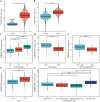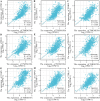TMEM150A overexpression was associated with poor prognosis and cancer progression in glioma verified by comprehensive analysis and cell experiments
- PMID: 40646078
- PMCID: PMC12254276
- DOI: 10.1038/s41598-025-08752-2
TMEM150A overexpression was associated with poor prognosis and cancer progression in glioma verified by comprehensive analysis and cell experiments
Abstract
Transmembrane (TMEM) proteins play a pivotal role in cancer progression, with TMEM150A specifically implicated in tumorigenesis. Despite its association with cancer, the precise role of TMEM150A in glioma remains underexplored. The expression of TMEM150A in glioma and its correlation with prognosis and the immune microenvironment were systematically analyzed. Prognostic models were developed using nomograms to establish the relationship between TMEM150A expression and patient survival. Bioinformatic analyses identified pathways and networks associated with TMEM150A co-expressed genes, while in vitro assays (CCK-8, migration, and invasion assays) examined the impact of TMEM150A inhibition on glioma cell proliferation and metastasis. TMEM150A was markedly overexpressed in glioma tissues and strongly associated with clinical features such as 1p/19q codeletion, age, IDH mutation status, histological subtype, WHO grade, and poor prognosis (P < 0.05). ROC analysis revealed high diagnostic accuracy, with area under the curve values of 0.962 and 0.896 for TCGA and XENA datasets, respectively, indicating the strong diagnostic potential of TMEM150A. Overexpression of TMEM150A was identified as a risk factor for poor prognosis. The constructed nomogram demonstrated that TMEM150A expression was predictive of survival, with time-dependent AUCs for 1, 3, and 5 years exceeding 0.75, confirming its prognostic relevance. TMEM150A co-expressed genes were linked to immune responses, necrotic cell death, antigen processing and presentation, cell differentiation, mast cell activation, endothelial cell migration, wound healing, and cell proliferation. Inhibition of TMEM150A expression suppressed U251 cell growth, migration, and invasion via epithelial-mesenchymal transition (EMT). Additionally, TMEM150A expression correlated with immune scores (r = 0.585), stromal scores (r = 0.498), ESTIMATE scores (r = 0.565), macrophage infiltration (r = 0.523), aDC (r = 0.473), and neutrophil presence (r = 0.453). Overexpression of TMEM150A serves as an independent prognostic marker in glioma and is intricately linked to the tumor's immune microenvironment. Targeting TMEM150A could inhibit glioma progression through EMT modulation, presenting a potential novel therapeutic avenue.
Keywords: EMT; Glioma; Immune microenvironment; Prognosis; TMEM150A.
© 2025. The Author(s).
Conflict of interest statement
Declarations. Competing interest: The authors declare no competing interests.
Figures














Similar articles
-
High ELK3 expression is associated with the wild type IDH1 in glioma and enhances infiltration of M2 macrophages.Int Immunopharmacol. 2025 Aug 28;161:115064. doi: 10.1016/j.intimp.2025.115064. Epub 2025 Jun 12. Int Immunopharmacol. 2025. PMID: 40513332
-
ELMOD2 Overexpression Predicts Adverse Outcomes and Regulates Tumor Progression in Gliomas.Curr Med Sci. 2025 Jun;45(3):549-561. doi: 10.1007/s11596-025-00057-9. Epub 2025 May 21. Curr Med Sci. 2025. PMID: 40397299
-
Expression of the IL-18-related gene PTX3 correlates with clinicopathological features and prognosis in glioma patients.PeerJ. 2025 Jul 10;13:e19675. doi: 10.7717/peerj.19675. eCollection 2025. PeerJ. 2025. PMID: 40656950 Free PMC article.
-
Cost-effectiveness of using prognostic information to select women with breast cancer for adjuvant systemic therapy.Health Technol Assess. 2006 Sep;10(34):iii-iv, ix-xi, 1-204. doi: 10.3310/hta10340. Health Technol Assess. 2006. PMID: 16959170
-
The effectiveness and cost-effectiveness of carmustine implants and temozolomide for the treatment of newly diagnosed high-grade glioma: a systematic review and economic evaluation.Health Technol Assess. 2007 Nov;11(45):iii-iv, ix-221. doi: 10.3310/hta11450. Health Technol Assess. 2007. PMID: 17999840
References
-
- Zhang, L., Wu, F. & Zhao, J. Transmembrane protein 45A regulates the proliferation, migration, and invasion of glioma cells through nuclear factor kappa-B. Anticancer Drugs.31(9), 900–907. 10.1097/CAD.0000000000000890 (2020). - PubMed
-
- Liu, J., Liu, Y., Ren, Y., Kang, L. & Zhang, L. Transmembrane protein with unknown function 16A overexpression promotes glioma formation through the nuclear factor-κB signaling pathway. Mol. Med. Rep.9(3), 1068–1074. 10.3892/mmr.2014.1888 (2014). - PubMed
MeSH terms
Substances
LinkOut - more resources
Full Text Sources
Medical

